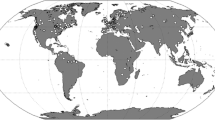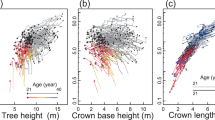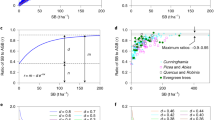Abstract
Key message
The present model indicates that possibility of leaf biomass constancy in forest stands is not so high, and that forest stand leaf biomass declines after canopy closure.
Abstract
Kira and Shidei (Jpn J Ecol 17:70–87, 1967) and Odum (Science 164:262–270, 1969) proposed a classical hypothetical trend that leaf biomass of a forest stand shows a more or less constant level after the initial peak maximum, with the result of constant GPP after canopy closure. On the contrary, Ryan et al. (Adv Ecol Res 27:213–262, 1997; Ecol Monogr 74:393–414, 2004) proposed a hypothetical trend that stand leaf biomass shows a singular peak maximum of leaf biomass, coinciding with canopy closure, with the result of singular peak of GPP. However, neither the hypothesis of leaf biomass constancy nor the hypothesis of a leaf biomass maximum explicitly states why leaf biomass should remain constant or decline after canopy closure from the mathematical or theoretical models. Therefore, age-related change in leaf biomass was modeled on the basis of the following three assumptions after canopy closure: (1) self-thinning law, (2) allometric scaling between mean individual leaf mass and mean individual total mass, and (3) formulation of a logistic function in stand density change. In the present modeling, both hypotheses can exist theoretically, but hypothesis by Kira and Shidei (Jpn J Ecol 17:70–87, 1967) and Odum (Science 164:262–270, 1969) holds only in a case limited mathematically. Using the reliable data on leaf biomass, leaf biomass constancy was also discussed by fitting mathematical model. From the empirical and theoretical viewpoints, possibility of leaf biomass constancy in forest stands is not so high, and it is reasonable that the forest stand leaf biomass declines after the canopy closure.




Similar content being viewed by others
References
Barnes VB, Zak DR, Denton SR, Spurr SH (1998) Forest ecology, 4th edn. Wiley, New York, p 774
Binkley D, Smith FW, Son Y (1995) Nutrient supply and declines in leaf area and production in lodgepole pine. Can J For Res 25:621–628
Conway TJ, Tans PP, Waterman LS, Thoning KW (1994) Evidence for interannual variability of the carbon cycle from the National Oceanic and Atmospheric Administration/Climate Monitoring and Diagnostics Laboratory Global Air Sampling Network. J Geophys Res 99:831–855
Enquist BJ, Brown JH, West GB (1998) Allometric scalling of plant energetics and population density. Nature 395:163–165
Hayashi Y (1988) Woody plants of Japan. Yama-Kei Publishers, Tokyo, p 751
Hozumi K (1973) Interactions among higher plants. Kyoritsu-shuppan, Tokyo, p 124
Hozumi K (1985) Phase diagramamatic approach to the analysis of growth curve using the u–w diagram—basic aspects. Bot Mag Tokyo 98:239–250
Hozumi K (1987) Analysis of growth curve of stem volume in some woody species using the u–w diagram. Bot Mag Tokyo 100:87–97
Kimmins JP (2004) Forest ecology. Prentice Hall, Upper Shaddle River, p 611
Kira T, Shidei T (1967) Primary production and turnover of organic matter in different forest ecosystems of the western Pacific. Jpn J Ecol 17:70–87
Kleiman D, Aarssen LW (2007) The leaf size/number trade-off in trees. J Ecol 95:376–382
Kohyama T (1982) Studies on the Abies population of Mt. Shimagare II. Reproductive and life history traits. Bot Mag Tokyo 95:167–181
Long JN, Smith FW (1992) Volume increment in Pinus contorta var. latifolia: the influence of stand development and crown dynamics. For Ecol Manage 53:53–64
Matthews HD (2005) Decrease of emissions required to stabilize atmospheric CO2 due to positive carbon cycle–climate feedbacks. Geophys Res Lett 32:L21707
Miyanishi K, Hoy AR, Cavers PB (1979) A general law of self-thinning in plant population. J Theor Biol 78:439–442
Nakashizuka T (1983) Regenation process of climax beech (Fagus crenata Blume) forests III. Structure and development process of sapling populations in different aged gaps. Jpn J Ecol 33:409–418
Nakashizuka T (1984) Regenation process of climax beech (Fagus crenata Blume) forests IV. Gap formation. Jpn J Ecol 34:75–85
Nakashizuka T, Numata M (1982a) Regenation process of climax beech (Fagus crenata Blume) forests I. Structure of a beech forest under the undergrowth of Sasa. Jpn J Ecol 32:57–67
Nakashizuka T, Numata M (1982b) Regenation process of climax beech (Fagus crenata Blume) forests II. Structure of a beech forest under the influences of grazing. Jpn J Ecol 32:473–482
Niklas KJ (1994) Plant allometry. The University of Chicago Press, Chicago, p 395
Odum EP (1969) The strategy of ecosystem development. Science 164:262–270
Ogawa K (2001) Time trajectories of mass and density in a Chamaecyparis obtusa seedling population. For Ecol Manag 142:291–296
Ogawa K (2005) Time-trajectory of mean phytomass and density during a course of self-thinning in a sugi (Cryptomeria japonica D. Don) plantation. For Ecol Manag 214:104–110
Ogawa K (2007) Self-thinning and stand dynamics of even-aged pure stands of sugi (Cryptomeria japonica) and hinoki cypress (Chamaecyparis obtusa). In: Scaggs AK (ed) New research on forest ecology. Nova Science Publishers, New York, pp 141–186
Ogawa K (2008) The leaf mass/number trade-off of Kleiman and Aarssen implies constancy of leaf biomass, its density and carbon uptake in forest stands: scaling up from shoot to stand level. J Ecol 96:188–191
Ogawa K (2012) Mathematical analysis of age-related changes in leaf biomass in forest stands. Can J For Res 42:356–363
Ogawa K (2015) Mathematical consideration of the pipe model theory in woody plant species. Trees Struct Funct 29:695–704
Ogawa K, Hagihara A (2003) Self-thinning and size variation in a sugi (Cryptomeria japonica D. Don) plantation. For Ecol Manag 174:415–423
Ogawa K, Hagihara A (2004) Relationship between maximum stem volume and density during a course of self-thinning in a sugi (Cryptomeria japonica) plantation. Korean J Ecol 27:27–33
Ogawa H, Kira T (1977) Primary production of Japanese forests. In: Kira T, Shidei T (eds) Methods of estimating forest biomass. University of Tokyo Press, Tokyo, pp 15–25/35–36
Ogawa K, Hagihara A, Hozumi K (1988) Photosynthesis and respiration in cones of hinoki (Chamaecyparis obtusa). J Jpn For Soc 70:220–226
Ogawa K, Adu-Bredu S, Yokota T, Hagihara A (2010) Leaf biomass changes with stand development of hinoki cypress (Chamaecyparis obtusa [Sieb. et Zucc.] Endl.). Plant Ecol 211:79–88
Perry DA (1994) Forest ecosystems. The Johns Hopkins University Press, Baltimore, p 649
Press WH, Teukolsky SA, Vetterling WT, Flannery BP (1992) Numerical recipes in C, 2nd edn. Cambridge University Press, Cambridge, p 702
Putz F, Parker GG, Archibald RM (1984) Mechanical abrasion and intercrown spacing. Am Midl Nat 112:24–28
Reineke LH (1933) Perfecting a stand-density index for even-aged forests. J Agric Res 46:627–638
Ryan MG, Binkley D, Fownes JH (1997) Age-related decline in forest productivity: pattern and process. Adv Ecol Res 27:213–262
Ryan MG, Binkley D, Fownes JH, Giardina CP, Senock RS (2004) An experimental test of the causes of forest growth decline with stand age. Ecol Monogr 74:393–414
Satoo T, Madgwick HAI (1982) Forest biomass. Martinus Nijhoff/Dr W Junk Publishers, The Hague, p 152
Schellnhuber HJ, Cramer W, Nakicenovic N, Wigley T, Yohe G (2006) Avoiding dangerous climate change. Cambridge University Press, Cambridge, p 392
Schulze E-D, Schulze W, Kelliher FM, Vyodskaya NN, Ziegler W, Kobak KI, Koch H, Arneth A, Kusnetsova WA, Sogatchev A, Issajev A, Bauer G, Hollinger DY (1995) Aboveground biomass and nitrogen nutrition in a chronosequence of pristine Dahurian Larix stands in eastern Siberia. Can J For Res 25:943–960
Schulze E-D, Beck E, Müller-Hohenstein K (2005) Plant ecology. Springer, Berlin, p 702
Shinozaki K (1962) Logistic theory of plant growth. PhD Thesis, Kyoto University, Kyoto, Japan, p 218
Shinozaki K, Yoda K, Hozumi K, Kira T (1964a) A quantitative analysis of plant form-the pipe model theory. I. Basic analysis. Jpn J Ecol 14:97–105
Shinozaki K, Yoda K, Hozumi K, Kira T (1964b) A quantitative analysis of plant form-the pipe model theory. II. Further evidence of the theory and its application in forest ecology. Jpn J Ecol 14:133–139
Silvertown J, Charlesworth D (2001) Introduction to plant population biology, 4th edn. Blackwell Science, Oxford, p 347
Spies TA, Franklin JF, Klopsch M (1990) Canopy gaps in Douglas-fir forests of the Cascade Mountains. Can J For Res 20:649–658
Sumida A, Miyaura T, Torii H (2013) Relationships of tree height and diameter at breast height revisited: analyses of stem growth using 20-year data of an even-aged Chamaecyparis obtusa stand. Tree Physiol 33:106–118
Suzuki E (1979) Regeneration of Tsuga sieboldii forest. I. Dynamics of development of a mature stand revealed by stem analysis data. Jpn J Ecol 29:375–386
Suzuki E (1980) Regeneration of Tsuga sieboldii forest. II. Two cases of regenerations occurred at 260 and 50 years ago. Jpn J Ecol 30:333–346
Suzuki E (1981a) Regeneration of Tsuga sieboldii forest. III. Regeneration under a canopy gap with low density level of conifer seedlings and a method for estimating the time of gap formation. Jpn J Ecol 31:307–316
Suzuki E (1981b) Regeneration of Tsuga sieboldii forest. IV. Temperate conifer forests of Kubotani-yama and its adjacent area. Jpn J Ecol 31:421–434
Tadaki Y (1977) Leaf biomass. In: Shidei T, Kira T (eds) Primary productivity of Japanese forests. University of Tokyo Press, Tokyo, Japan, pp 39–44/57–62
West GB, Brown JH, Enquist BJ (1997) A general model for the origin of allometric scaling laws in biology. Science 276:122–126
Yato K (1978) Dendrology—Coniferous species. Japan, Asakura-shoten, p 189
Yoda K, Kira T, Ogawa H, Hozumi K (1963) Self-thinning in overcrowded pure stands under cultivated and natural conditions. (Intraspecific competition among higher plants XI). J Biol Osaka City Univ 14:107–129
Acknowledgments
I thank the staff of the Nagoya Regional Forest Office and the Midorigaoka Nursery attached to the Gifu District Forest Office for providing the seedlings, and my colleagues for their assistance during field work.
Author information
Authors and Affiliations
Corresponding author
Ethics declarations
Conflict of interest
The author (KO) declares that he has no conflict of interest.
Additional information
Communicated by E. Priesack.
Rights and permissions
About this article
Cite this article
Ogawa, K. Modeling age-related leaf biomass changes in forest stands under the assumptions of the self-thinning law. Trees 31, 165–172 (2017). https://doi.org/10.1007/s00468-016-1465-7
Received:
Accepted:
Published:
Issue Date:
DOI: https://doi.org/10.1007/s00468-016-1465-7




